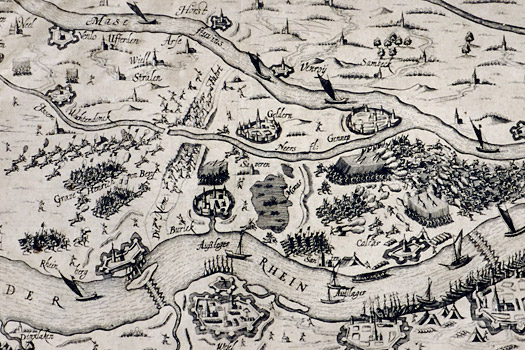
Spanier und Niederländer am Niederrhein
Baudenkmale am Niederrhein bezeugen die dortigen, oft militärischen Konflikte infolge von Reformation und Gegenreformation sowie dynastische Auseinandersetzungen. Teile dieser im Ruhrgebiet liegenden Gebiete gehörten in der Frühen Neuzeit zum niederländischen Einflussbereich, um den sich Spanier und Oranier stritten. Der Kupferstich von Abraham Verhoeven zeigt Kämpfe zwischen spanischen und niederländischen Truppen, entlang der Fossa Eugeniana.
© Stadtarchiv Rheinberg
Herrschaft zurück zur Auswahl
The Spanish and the Dutch in the Lower Rhine
Fortresses and the remnants of a canal as reminders of long years of conflict
A great number of architectural monuments particularly along the Lower Rhine testify of conflicts in that region of frequently military nature, brought on by the Reformation and the Counter-reformation as well as dynastic disputes. In the early modern period, parts of the land now lying within today's Ruhr Region fell under Dutch influence, a region for which the Spanish and the house of Orange fought each other. Moritz von Orange-Nassau who at the end of the 16th century, inherited the county and the town of Moers which he first had to conquer from the Spanish, had castle and town converted into one of the most modern forts of its time. The goal was to place the ramparts far into the foreground. In this way the key spots, the town and the castle, could be kept out of the battle zone. By 1620, town and castle had received a more or less star-shaped, fortifying enclosure, in the manner of the Dutch system. The fortress of Moers had been never attacked, but already in the 18th century was regarded as obsolete. By succession, the county of Moers went to the Prussians in 1702, er of which a bronze statue of Electress Luise-Henriette reminds us. The pedestal of the statue bears the crests of Nassau-Orange and Brandenburg-Prussia, pierced and thus pinned together by Cupid's arrow.
In the 17th century Spain constructed a channel along the Lower Rhine for military purposes, intended to connect the rivers Rhine and Maas. The Spanish royal dynasty was in a decade-long war with the States-General, the united seven northern provinces, over the control of the Netherlands. An economic blockade was intended to bring the States-General to their knees, and the canal, named after the Spanish governor Isabella Clara Eugenia, was intended to divert trading ships from the Rhine to the Maas. The canal was never completed, but sections of it remain preserved near Rheinberg.
Denkmale zum Impuls
Moers - Wallanlage und Schloss
Die beeindruckende Struktur des Parks, der Schloss Moers umgibt, geht auf eine ... weiter
Rheinberg - Schleuse Fossa Eugenia
Den Namen „Fossa Eugeniana“ verdankt der Kanal Isabella Eugenia Clara, die als ... weiter
Moers - Denkmäler für Friedrich I. und seine Mutter
Vor dem Moerser Schloss steht das 1904 von Heinrich Baucke realisierte Denkmal für die ... weiter

